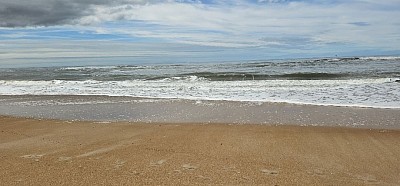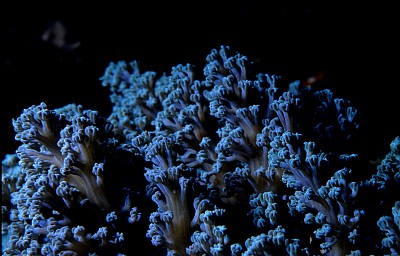Agatized Coral:
Daytona Beach Rockhounding Guide
A Comprehensive Guide to Rockhounding in
Daytona Beach, Florida
Introduction
Rockhounding, the hobby of collecting rocks and minerals from their natural environment, offers a captivating exploration of nature's geological treasures. Daytona Beach, Florida, is renowned among rockhounders for its diverse and attractive stones, supported by a unique geological makeup. This guide explores the excitement, techniques, and skills needed for successful rockhounding in Daytona Beach.
Rocks and Minerals You Will Find
Common Finds: Florida's geology is highlighted by vast phosphate deposits, making fossilized shark teeth and chemically altered shells common discoveries (Bridges, 2022) [^1^]. Additionally, quartz and silicates such as agate and jasper are frequently found on Daytona Beach, prized for their resistance to weathering (Florida Geology, n.d.) [^2^].
Rare Finds: Occasionally, rockhounders may uncover rare specimens like marine aragonite, a delicate mineral known for its lustrous beauty (Sanders, 2017) [^3^].
Best Times for Rockhounding
Rockhounding can be enjoyed year-round, but the best times to visit Daytona Beach are during low tides, especially after storms. These conditions often reveal new treasures washed up from the ocean depths (Smith, 2019) [^4^].
Essential Rockhounding Tools
Key equipment includes rock hammers, hard hats, safety glasses, and gloves. A sieve is invaluable for sifting through sand and water to separate finds from sediment. For fossil hunters, a UV lamp can be surprisingly effective in identifying phosphatic fossils (Merkel, 2020) [^5^].
Safety Precautions
While rockhounding is an adventurous activity, safety is paramount. Always carry a first aid kit for minor injuries and wear protective outdoor clothing to guard against the elements and sharp rocks. Maintain steady footing when wading in water, and inform someone of your location and expected return time.
Legal Considerations
It is important to be aware that Florida law prohibits collecting vertebrate fossils without a permit on state lands, including submerged areas (Florida Museum, n.d.) [^6^]. However, invertebrate and plant fossils may be collected freely, so always check local regulations before collecting.
Exploring Different Beaches of Daytona Beach
- Daytona Main Beach: Known for its vibrant nightlife, this beach reveals quartz and silicates during early morning low tides.
- Ormond Beach: A quieter area popular for finding smaller shark teeth fossils.
- Silver Beach Ave: A family-friendly beach ideal for beginners seeking easily accessible sedimentary rocks.
Conclusion
Daytona Beach is a rewarding destination for both seasoned and novice rockhounders. Success requires a keen eye, some luck, and respect for regulations. The joy of uncovering hidden geological treasures while enjoying the serene Florida coastline is an unparalleled experience.
- [^1^]: https://wuft.org/news/2022/01/17/florida-frontiers-searching-for-fossils-in-florida/
- [^2^]: http://florida.geology.acsitefactory.com/florida-geology/rocks-and-minerals-florida
- [^3^]: https://www.coastalliving.com/travel/best-beachcombing-beaches
- [^4^]: https://rockandmineralshows.com/Search/ClubDetail/uid/108
- [^5^]: https://www.mining-technology.com/features/feature-top-7-biggest-mining-excavators-in-the-world/
- [^6^]: https://www.floridamuseum.ufl.edu/vertpaleo/amateur-collector/fossil-collecting/
An Ocean Beauty and Metaphysical Marvel Agatized coral, also known as fossil coral
The world of fossil hunting opens doors to an intriguing journey through time. Among the myriad items sought by collectors and geologists are agatized corals—an impressive blend of natural history and mineral beauty. These fossils serve as vital puzzle pieces in understanding Earth’s geological and climatological history. This guide offers a comprehensive overview of finding these geological marvels, emphasizing their significance and the importance of environmental responsibility during exploration.
What Are Agatized Corals?
Agatized corals are the petrified remnants of prehistoric underwater ecosystems, crystallized over millions of years. They are highly prized for their intricate structures and the stories they reveal about Earth’s evolutionary past. To the untrained eye, they may appear as ordinary rocks, but closer examination uncovers detailed patterns and formations that confirm their biological origin.
Where and How to Find Agatized Corals
Successfully locating agatized corals requires a combination of knowledge, patience, and ethical practice. The first step is understanding where to search and how to identify agatized coral in the field. Florida, especially the Tampa Bay area, is a prime location for coral fossil hunting, as it was once submerged beneath ancient seas, leaving behind abundant agatized coral deposits within rocks and limestone. Other notable regions include parts of the western United States, such as Nevada and Arizona. Familiarizing yourself with the unique characteristics of agatized coral is essential for accurate identification.
Identifying Characteristics
Agatized corals exhibit a wide range of colors, shapes, and sizes, from milky white to deep black hues. Their structures vary from tiny starburst-like patterns to larger, tree-like formations. Look for distinctive lines and patterns—hallmarks of fossilized coral. Using a hand lens or magnifying glass can help reveal these intricate details. Additionally, performing a hardness test can confirm your find, as agatized coral contains quartz and will scratch glass.
Ethical Considerations in Fossil Hunting
The pursuit of agatized coral is not only about discovery but also about respecting the environment and geological heritage. Responsible fossil hunting involves obtaining necessary permits, adhering to local and national laws, and following Leave No Trace principles to minimize impact on natural sites.
Contributing to Science
Accurately documenting your finds—including their exact location, date, and surrounding environment—can greatly benefit the scientific community. Sharing your discoveries with local museums or geological societies helps broaden understanding of Earth’s history and supports ongoing research.
Commercial Considerations
While some collectors trade or sell agatized coral, it is important to recognize that commercialization can diminish their scientific value. Collectors are encouraged to appreciate these specimens for their intrinsic worth as artifacts of Earth’s past rather than as commodities.
Conclusion: A Journey Through Time
The quest to find agatized coral is an exciting adventure that deepens our connection to planetary history. It demands knowledge, patience, and respect for Earth’s complex geology. Each discovery is a handshake with the past, carrying the responsibility to preserve these treasures for future generations.
Embracing this journey enriches your appreciation of nature’s beauty, the timelessness of evolution, and our stewardship role in protecting these wonders. Remember, collecting agatized corals is only part of the experience; understanding their story and honoring their origins are equally important.
With every step closer to uncovering a piece of agatized coral, you tread upon remnants of an ancient era—a story millions of years in the making. By responsibly seeking, finding, and preserving these fossils, we keep history alive, inspire wonder, and foster respect for the natural world and its remarkable gifts.
Embark on your fossil hunting adventure equipped with knowledge, reverence for nature, and excitement to discover geological marvels. You never know what piece of history you might uncover in your pursuit of agatized corals. Each find brings us closer to a comprehensive understanding of our planet’s geological and biological narrative, written in the very stones beneath our feet.


